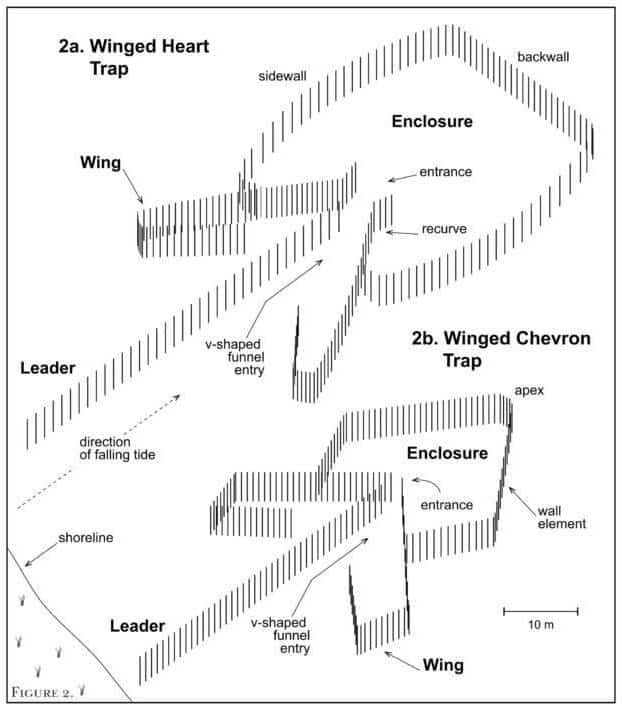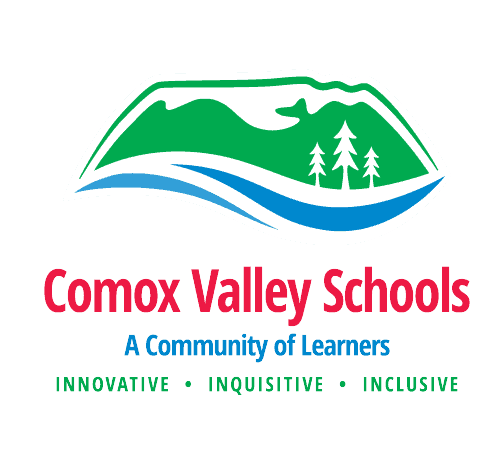Fish Traps
Fish Trap Experience Video by Fox and Bee Media
Either scroll to the botom on the above link for click on the following for some incredible photos and quotes.
Unveiling incredible Pentlatch fish trap panel exhibit at VIU’s Deep Bay Marine Field Station
Photos
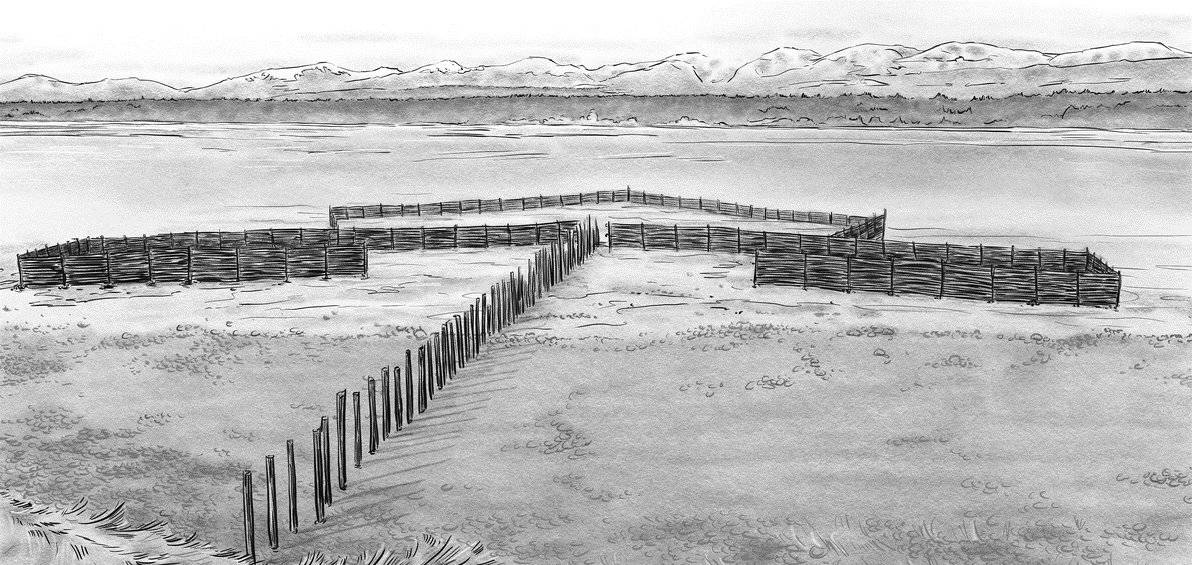
Artistic representation of a winged chevron fish trap; illustration by Eric Simons in Tidal Belongings: First Nations-driven Archaeology, Connaughton et al. 2022.
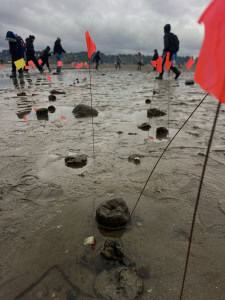 Fish Trap Visit Photo Taken by Erin Kotyk |
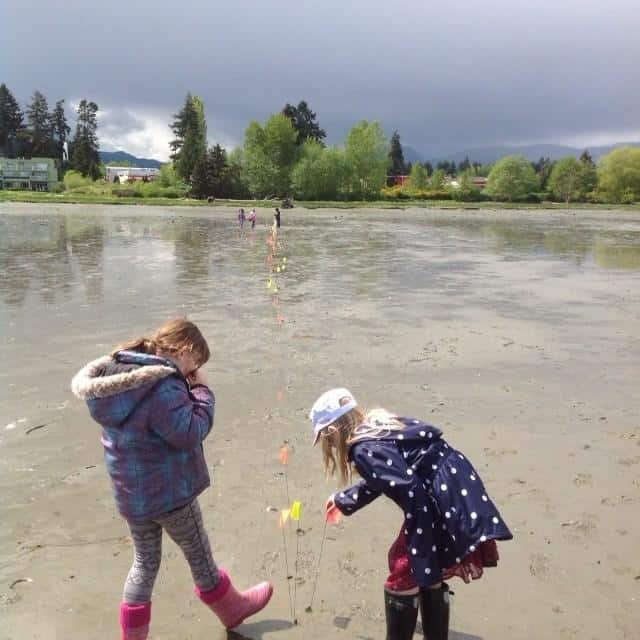 |
Visiting the Fish Traps
The SD71 Indigenous Curriculum Support Teachers, in continued collaboration with Guardians of the K’omoks First Nation, have a limited number of spaces to take classes who have been working on curriculum that would connect to this local wonder on site visit. Please be respectful of this culturally important place, and connect with the Indigenous Education Department if you wish to plan a visit. We liaise with the K’omoks First Nation Guardians, as the caretakers and stewards of this land, to inform and invite them to any booked School District field trips. If you have gone on this trip before with a SD71 Indigenous Education Staff member and would like to go again, please still inform us and we will keep a schedule of people attending so that we can inform the K’omoks First Nation Guardians.
This page has some great background information and lessons plans to prepare your class.
School District #71 staff, please see following link for low tide times that are compatible to school hours and for other pertinent booking and field trip information such as meeting place and appropriate clothing – Fish Trap Visit Times.
Learning Considerations
Teaching Materials:
Building background knowledge for the students prior to their visit to the fish traps is an important part of this experience. Not only does it build a foundation of knowledge for the students to attach meaning to, but it also provides a wonderful opportunity for students to build their skills in other parts of the curriculum. Additionally, it brings us back to our intention of building relationships between students and the local environment, where the Pentl’atch, E’iksan, Sathloot and Sasitla, now known as K’omoks First Nations peoples, have been caretakers since time immemorial.
One successful strategy that has been used in the past is to begin the students’ learning with the Boxing Strategy (below). This interactive activity activates prior knowledge, sparks curiosity, fosters engagement and connections to the fish traps, and provides meaningful opportunities for students to develop oral language skills through communication and collaboration.
After small groups circulate through the stations, making observations, writing down questions, and sharing inferences, the class comes together for a whole group discussion. This provides an excellent opportunity to introduce key ideas and vocabulary. To conclude this lesson, we share the video above, pausing throughout to make connections to the images explored in the Boxing Strategy.
Pre-Visit Suggestion
-
- Boxing Strategy Fish Trap Think Notice Wonder
Post-Visit Reflection Suggestion
Found Artifacts and Repatriation
Before visiting the fish traps or on any field trip please review this pamphlet provided by K’ómoks First Nation Archeology Department. Thank you to Claire Everson for your work on this pamphlet to share with School District #71 staff and students.
SD71 – KFN Repatriation Pamphlet (print on both sides – flip on the short edge)
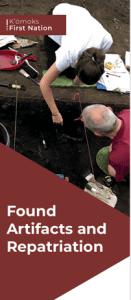
Caretaking of the Land – information for your visit
We have been graced permission and support from the K’omoks First Nation to teach about the fish traps to classes that come down to the harbour. Ideas to the K’omoks First Nation that are important and put into practice are sustainability, respect and caretaking of the land. In your pre-teaching lessons, please talk to your students about this same practice while visiting outdoor areas and while on this tour. Please specifically ask students to tread lightly on the shoreline, leave everything in its place, especially the small crabs that they will see when on the harbour (leave creatures on the ground, do not step on them or poke them with sticks).
One way to begin this conversation is to highlight the importance of respecting nature and discussing how each living and non-living thing interacts with other parts of its ecosystem.
We find a reminder about what outdoor learning looks like and sounds like is quite helpful. This includes talking about how outdoor learning looks different than free beach time playing.
Thanks all for helping to ensure that this is a successful and meaningful visit!
In most school libraries, you will find the book called, Orca Chief, by Roy Henry Vickers. It could be one way start a discussion with your class about respecting the environment.
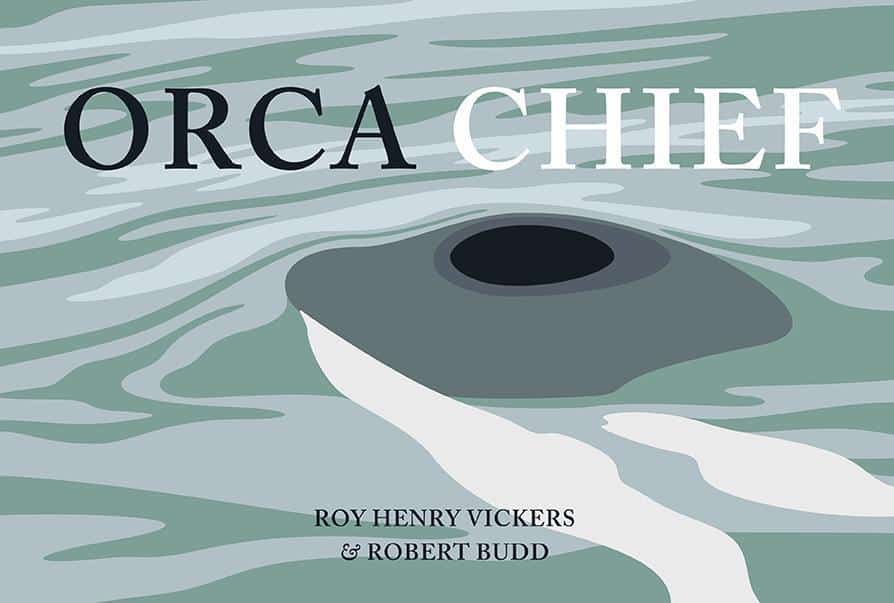
Includes:
Fishing Since Time Immemorial, Coast Salish Harvesting Methods, The introduction of canneries and a wage-based economy, The creation of an Aboriginal “food fishery”, Aboriginal fisheries in the courts: Sparrow, Van der Peet, and other legal challenges, Not a “race-based” fishery.
Link: http://indigenousfoundations.arts.ubc.ca/aboriginal_fisheries_in_british_columbia/
Kus-Kus-Um – Unpave Paradise Project
by Jessica Speck – a journey spearheaded by project Watershed to restore the old Fields Sawmill site back it nature to help preserve the Comox Valley estuary and it’s diverse eco-system.

